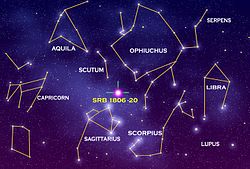SGR 1806-20
| SGR 1806-20 | ||
|---|---|---|

| ||
SGR 1806-20の天球上での位置を示した図。 | ||
| 星座 | いて座 | |
| 見かけの等級 (mv) | 非常に暗い | |
| 分類 | 中性子星 | |
| 位置 元期:J2000.0 | ||
| 赤経 (RA, α) | 18h 08m 39.32s | |
| 赤緯 (Dec, δ) | −20° 24′ 39.5″ | |
| 距離 | 15,000 パーセク[1] | |
| 物理的性質 | ||
| 半径 | 0.000025 R☉ | |
| 質量 | 1.2391 M☉ | |
| 自転周期 | 7.56 秒[1] | |
| 光度 | <3.94×1013 L☉ | |
| 他のカタログでの名称 | ||
| GRB 790107, INTEGRAL1 84, AX 1805.7-2025 GRB 970912, INTREF 882, CXOU J180839.3-202439, HETE Trigger 1566, KONUS 07.01.79, EQ 1805.7-2025, HETE Trigger 3801, PSR J1808-2024, GBS 1806-20, HETE Trigger 3800, RX J1808.6-2024 | ||
| ■Template (■ノート ■解説) ■Project | ||
SGR 1806-20は、史上一番初めに発見されたマグネターであり[2]地球から約5万光年離れたC1 1806-20星団にある[3]。
発見された当時はガンマ線を出す天体GB 970107として見つけられ[4]、1986年に軟ガンマ線リピーターとして知られるようになった[5]。1993年には、中性子星だと判明した[6]。1998年パルサーだとわかると同時に、とりわけ強い磁場を持つことがわかり、マグネターであることが判明した[7][8][9]。
位置[編集]
SGR 1806-20は、地球から見て銀河系の中心部をはさんで反対側、いて座の方向に約5万光年離れた位置にある星雲G10.0-0.3の中心部にあり、それに属するC1 1806-20星団は、銀河系最大のHII領域である[要出典]。1806-20星団には、知られている中で最も明るい恒星である高光度青色変光星LBV 1806-20や、炭素に富むWC9d型やWCL型のウォルフ・ライエ星など、珍しい恒星がいくつか含まれている[10]発見と研究の歴史[編集]
SGR 1806-20は、始め1979年1月7日にガンマ線を出す天体として発見された(バースト‥GB970107)[4]、 1986年に軟ガンマ線リピーターとして知られるようになり[5]、1987年にSGR 1806-20と命名された[2]。1993年には電波望遠鏡による観測で超新星残骸の中にあることがわかり、中性子星だと判明した[6]。しかし、当時はガンマ線を出すメカニズムはわからなかった。1998年にこの天体が強い磁場を持つパルサーであることがわかると同時に、軟ガンマ線リピーターはマグネターである事が判明した[7][8][9]。 1995年にはこの天体がLBV 1806-20の伴星だという可能性が取りざたされたが[11]、 LBV 1806-20の伴星だという可能性は2002年に否定された[12]。物理的性質[編集]
SGR 1806-20は、直径が34km程の中性子星で、自転周期は7.56秒[1]のパルサーである。X線で観測されたパルサーの名前はPSR J 1808-2024という[12]。表面は最大で14.5km/sの速度で回転している。自転の速度は他のパルサーに比べて極めて速く減速している[8]。SGR 1806-20は8 x 1010Tという極めて強力な磁場を持つマグネターである[8]。その強さは地磁気の2000兆倍という強力なもので、通常のパルサーの100万倍以上である[13]。1998年現在で知られている中で一番強い磁場を持つマグネターである[8]。銀河系に存在するマグネターは数個程度であろうと言われている[14]。また、このマグネターの存在する超新星残骸の年齢が1万年程度であると推定されていること[15]などから、個々のマグネターが軟ガンマ線リピーターとして観測される期間はその一生に比べて短いと推定されている[13]。爆発[編集]
軟ガンマ線リピーターは1秒以下のガンマ線のフレアーと数秒の周期を持つパルサー由来のかなり長期にわたるガンマ線の信号の2種類の信号を放出をする[8]。前者は、超新星爆発と見間違えられやすいが、400秒近くに上る極めて長い後者の信号を伴う[1]ので区別できる。 例えば2004年12月27日にはこの天体の大爆発に伴って放出された大量のガンマ線が地球まで達した。ガンマ線のエネルギーは150〜200 KeVだった[1]。ガンマ線は地球大気上層部の電離層に衝突し、多くのイオン化された粒子を発生させた。この爆発現象は﹁星震﹂と呼ばれ、総エネルギーは、マグニチュード23.1 (3.0×1039J) に達すると推定されている。これは、銀河系内で起こったものとしては、1604年の超新星爆発SN 1604以来の高エネルギー現象であると考えられている。この現象はSGR 1806-20の表面が一部、あるいは全球面破壊された際に発生したと推定されている。爆発に伴うフレアは6分20秒[1]と長く、最初の0.2秒間で太陽が25万年かけて放出するエネルギーと等しいエネルギーを放出したと推定され[1]、その明るさは太陽の40兆倍、絶対等級-29.2等級に達したと推定されている。 もしこの星震が3光年以内の距離で発生していれば、地球のオゾン層は完全に破壊され、地球のどこでも7.5km先での12キロトン(50兆J)の核爆発 (広島型原爆とほぼ同程度) が起きたのと同じ影響がでると予想されている[要出典]。知られている限りで最も地球に近いマグネターは、りゅうこつ座の方向にある1E 1048.1-5937の9000光年である。出典[編集]
- ^ a b c d e f g Hurley, K. et al. (2005). “An exceptionally bright flare from SGR 1806-20 and the origins of short-duration γ-ray bursts”. Nature 434 (7037): 1098-1103. arXiv:astro-ph/0502329v2. Bibcode: 2005Natur.434.1098H. doi:10.1038/nature03519. ISSN 0028-0836.
- ^ a b Laros, J. G. et al. (1987). “A New type of repetitive behavior in a High-Energy Transient”. Astrophysical J. 320: L111-L115. Bibcode: 1987ApJ...320.111L Check bibcode: length (help).
- ^ Corbel, S.; Eikenberry, S. (2004). “The Connection between W31, GR 1806-20 and LBV 2806-20: Distance, extinction and structure”. Astronomy and Astrophysics 419: 191-21-. Bibcode: 2004A&A...419..191C.
- ^ a b Mazets, E. P. et al. (1981). “Recent results from the gamma-ray burst studies in the KONUS experiment”. Astrophysics and Space Science 75: 47-81. Bibcode: 1981Ap&SS..75...47M.
- ^ a b Laros, J. G. et al. (1986). “The soft gamma-ray burst GB790107”. Nature 322: 152-153. Bibcode: 1986Natur.322..152L.
- ^ a b Kulkarni, S. R.; Frall, D. A. (1993). “Identification of a supernova remnant coincident with the soft γ-ray repeater SGR1806 - 20”. Nature 365 (6441): 33-35. Bibcode: 1993Natur.365...33K. doi:10.1038/365033a0. ISSN 0028-0836.
- ^ a b “Magnetar discovery solves 19yr old mystery in astrophysics”. NASA (1998年). 2017年4月20日閲覧。
- ^ a b c d e f Kouveliotou, C. et al. (1998). “An X-ray pulsar with a superstrong magnetic field in the soft γ-ray repeater SGR1806 - 20”. Nature 393 (6682): 235-237. Bibcode: 1998Natur.393..235K. doi:10.1038/30410. ISSN 00280836.
- ^ a b Kouveliotou, C. et al. (1999). “Discovery of a Magnetar Associated with the Soft Gamma Repeater SGR 1900+14”. The Astrophysical Journal 510 (2): L115-L118. arXiv:astro-ph/9809140v2. Bibcode: 1999ApJ...510L.115K. doi:10.1086/311813. ISSN 0004637X.
- ^ Figer, Donald F. et al. (2005). “Massive stars in the SGR 1806-20 Cluster”. Astrophysical Journal 522: L49-L52. Bibcode: 2005ApJ...622L..49F.
- ^ van Kerkwijk, M. H. et al (1995). “A lumious companion to SGR 1806-20”. Astrophysical J. 444. Bibcode: 1995ApJ...444L..33V.
- ^ a b Kaplan, D. et al. (2002). “Precise Chandra Localization of the Soft Gamma-Ray Repeater SGR 1806-20”. Astrophysical J. 564: 935-940. Bibcode: 2002ApJ...564..935K.
- ^ a b Carrol, Bradley W.; Ostlie =, Dale A. (2007). Introduction to Modern Astrophsyics (2nd ed.). San Francisco, CA, USA: Pearson / Addison-Wesley. pp. 602-603. ISBN 0-8053-0402-9
- ^ Kouveliotou, C. et al. (1994). “The rarity of soft gamm-ray repeaters deduced from reactivation of SGR 1806-20”. Nature 368: 125-127. Bibcode: 1994Natur.368..125K.
- ^ Kulkarni, S. R.; Frail, D. A. et al. (1994). “The radio nebula of the soft gamma-ray repeater 1806-20”. Nature 368: 129-131. Bibcode: 1994Natur.368..129K.
関連項目[編集]
- マグネター - 中性子星
- 軟ガンマ線リピーター - ガンマ線バースト
